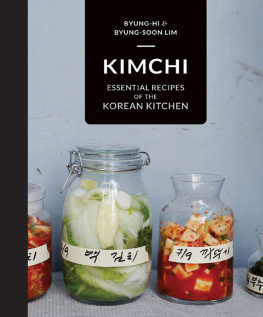




This book is dedicated to my two mothers,
one who gave me life and the other who helped me live it.

Contents
Foreword
W hen I was growing up in Alsace, France, my room was just above the kitchen. My mother and grandmother used to prepare meals for the familys coal company employees. Big pots of traditional Alsatian foods bubbled below, and the scent would just waft up into my room. I loved watching them cook, and eventually I became the family palateId taste the food and tell my mom what was missing: a little salt here, a little butter there. One day, I realized that I wanted to cook for a living, and I was lucky enough to apprentice with some of the greatest chefs in France. I was trained in classical French techniques, which were firmly based in stocks that took hours to make and were heavy on the butter and cream.
When I was 23, I moved to Bangkok to work at the Mandarin Oriental. It was the first time that I had ever traveled that far from home. On my way to the hotel from the airport, I stopped at a food stand on the side of the street and had a simple soup that changed my life. This woman put a pot over a portable burner, added some water, lemongrass, a little shrimp, and in minutes whipped up one of the most flavorful broths I had ever tasted. It went against everything I had learned, and from that moment all I wanted to do was to go into the markets to explore these new flavors. Endless chiles and spices, new fruits and vegetables that I had never seen before, it was all there for me to discover. It transformed the way that I cooked, and today I continue to be inspired by these bright and intense flavors.
When I met Marja, my life changed in every way, even expanding my palate. Falling in love with her meant falling in love with Korean food, even though it took me some time to come around. When we moved in together, I opened the refrigerator and was turned off by a completely overpowering aroma. (Anyone whos had a jar of kimchi in their fridge knows what Im talking about.) I gave it a taste, though, and now Im addicted. It reminds me of the sauerkraut of my childhood, but even better because its got a spicy kick. Actually, the more Korean food I eat, the more I realize how similar it is to Alsatian food. Both rely heavily on cabbage and pork; both emphasize frugality and seasonality; both are unpretentious ).
Traveling to Korea with Marja to tape Kimchi Chronicles allowed me to discover the origins of many of the meals I love that Marja makes at home, like bulgogi and chicken braised with vegetables and gochujang, the red pepper paste thats the backbone of the Korean kitchen. Like the food I tried in Thailand years ago, Korean cooking allows you to achieve deep, developed flavors in a relatively short time, which, incidentally, makes it great for entertaining. On weekends in our country home, the kitchen counter is filled with simple, comforting Korean dishes that our friends and family devour. Marja often makes bindaetteok (page ) to eat with cocktails, which lately consist of freshly squeezed grapefruit juice mixed with Korean soju. Sometimes Ill grill something simple, like a good steak, and well eat it with whatever vegetables are in season and some rice and kimchi on the side.
Ive incorporated Korean food not just into my personal life, but also into my professional repertoire. Im working on putting a hot dog with kimchi relish like the one on page ) comes tucked underneath a nicely seared piece of fish, giving it just the right spicy bite.
Korean food is Marjas passion, and it has been one of the most important ways for her to reconnect with her roots. Ive followed her through her journey, and have been lucky to learn about the flavors and traditions of Korean cuisine. Today, were excited to be able to share all that weve learned and have come to love about Korean foods and traditions not only with the Kimchi Chronicles television show, but also with this cookbook. We both hope that youll enjoy the journey as much as we have.
Jean-Georges Vongerichten, winter 2011

Everyone has a right to know his rootsfrom whence he came.
It helps us formulate a concept of who we are and determine where we want to go.
Margo McKay
Introduction
H ow did I, little old me from Uijeongbu, Korea, end up hosting a public television series on Korean food and culture and writing a Korean cookbook? It starts, as many good things do, in a restaurantin this instance a place on Manhattans Columbus Circle called Jean-Georges owned by my husband, Jean-Georges Vongerichten. I was talking with Charlie Pinsky and Eric Rhee, friends of JGs who produced the wonderful public television series Spain... On the Road Again among many others. They were looking for a new project to follow up on the success of that one, and had in mind a series about Korea, a country they considered long overdue for wider exposure and rife with intriguing food, culture, and sites. They knew that I had been born in Korea to a Korean mother, was adopted and raised in the States, and have spent my adult life reuniting with my Korean family, often using food as a means to understanding my background and my culture. When they offered me the opportunity to introduce the ingredients, customs, and people of my native country to a larger audience, I said all right!
During the last year Ive traveled all over Korea with a terrific crew and also brought them into my home kitchen in New York to re-create some of the flavors and dishes we had encountered overseas for my public television series, Kimchi Chronicles. Weve even invited some fun companions along for the journey, including our neighbors Hugh and Deb Jackman and my sweet friend Heather Graham. At the end of it all Im thrilled to have created so many converts to the pleasures of the Korean table, and to show those not familiar with the foods and logistics of a Korean meal how well this style of eating fits with the way many of us like to eat today.
I am passionate about Korean cuisines approachability and health benefits, about the way everyone eats together and shares everything, about the way it has connected me so closely with so many people in my life.
In a sense you might say that I myself am a somewhat recent convert to the joys of Korean food, having been raised on the typical American diet for most of my first two decades. The earliest record of my existence is a birth certificate dated August 7, 1979 (although I was born on March 15, 1976). My mother Yong Ye was a 19-year-old Korean woman, my father an African-American serviceman who abandoned her when she was 7 months pregnant with me. Left alone with an infant and no financial support, she faced incredible hardship.
Next page














